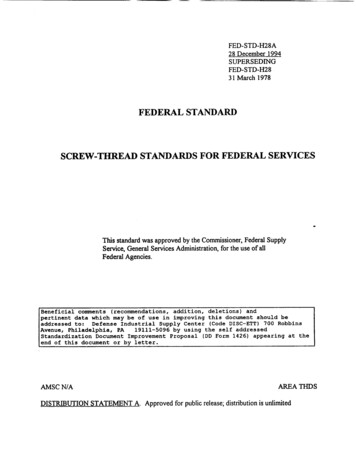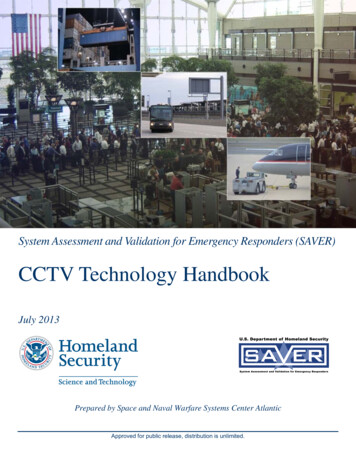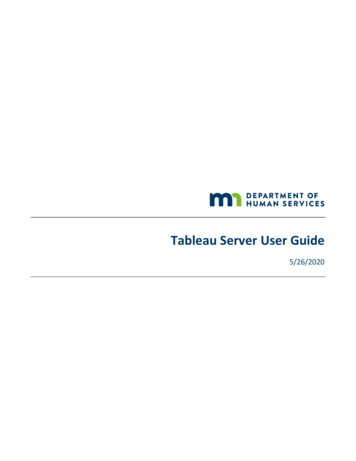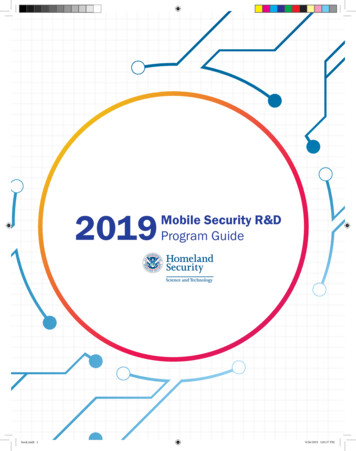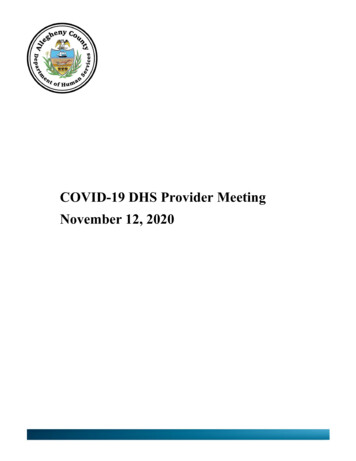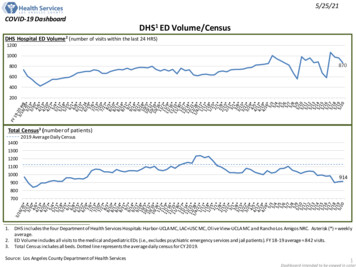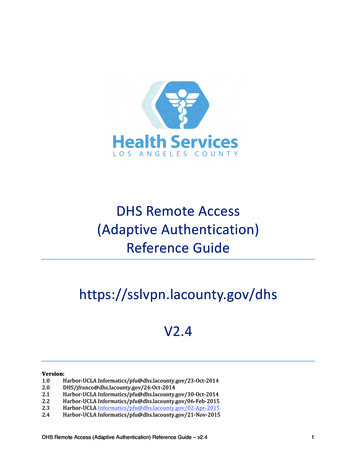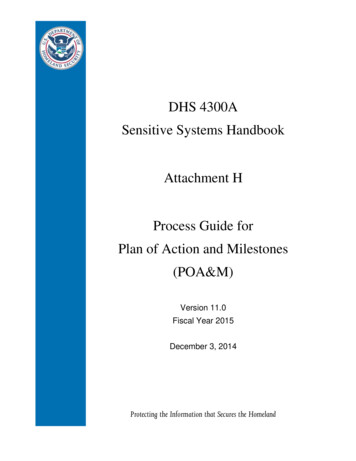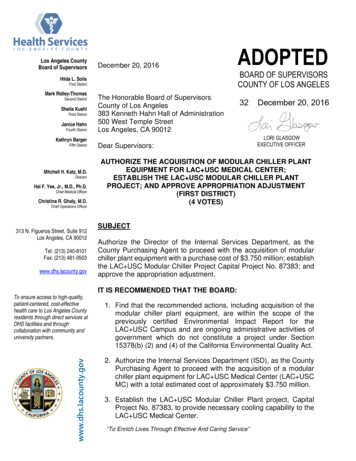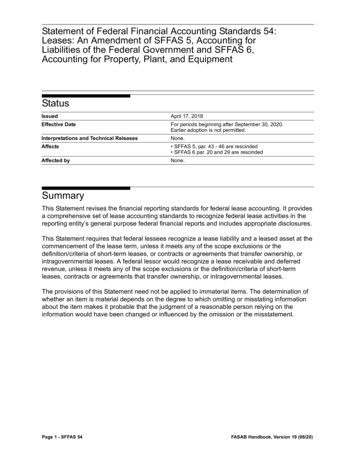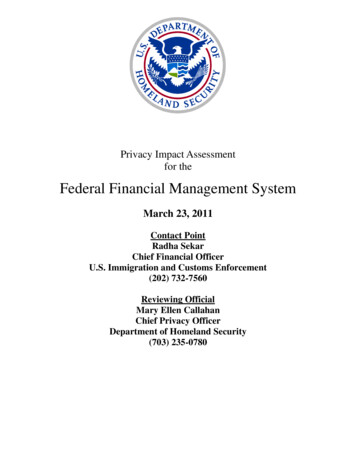
Transcription
Privacy Impact Assessmentfor theFederal Financial Management SystemMarch 23, 2011Contact PointRadha SekarChief Financial OfficerU.S. Immigration and Customs Enforcement(202) 732-7560Reviewing OfficialMary Ellen CallahanChief Privacy OfficerDepartment of Homeland Security(703) 235-0780
Privacy Impact AssessmentICE, Federal Financial Management System (FFMS)Page 2AbstractThe Federal Financial Management System (FFMS) is a web-based, workflow management andfinancial transaction system that provides core financial management functions for U.S. Immigration andCustoms Enforcement (ICE) and five other components within the Department of Homeland Security(DHS): U.S. Citizenship and Immigration Services (USCIS), Science & Technology (S&T), the NationalProtection Programs Directorate (NPPD), Office of Health Affairs (OHA), and DHS Office ofManagement (MGMT). FFMS is used to create and maintain a record of each allocation, commitment,obligation, travel advance and accounts receivable issued. The system contains personally identifiableinformation (PII) about DHS employees, contractors/vendors, customers and members of the public thatparticipate in DHS programs. ICE is conducting this privacy impact assessment (PIA) because FFMScollects and maintains PII. This PIA focuses on ICE’s collection and use of PII, and each component willpublish appendices to this PIA as required to describe their collection and use of PII in FFMS.OverviewBackgroundICE’s Office of the Chief Financial Officer (OCFO), Office of Financial Management (OFM) isresponsible for operating and maintaining FFMS, which supports financial management activities andprocesses for ICE and five other DHS components, specifically, USCIS, S&T, NPPD, OHA, and MGMT.All six components use FFMS for recording and processing commitments, obligations, collections andpayments (collectively “financial transactions”), which are defined as follows:Commitments: The reservation of agency funds to ensure the availability of those fundsbefore the agency awards a contract for goods or services, or for anticipated expendituressuch as payroll and contingent liabilities.Obligations: The designation of agency funds toward a legal liability or definite promise topay for goods and services received or ordered. Examples of liabilities are: procured goodsor services under a government contract, for monthly payments on a lease, governmentpurchase card transactions, DHS employee travel or relocations, etc.Collections: Invoices sent to and payments received by the agency, often from customers(i.e., other federal, state and local agencies) for goods or services provided by the agency.Payments:obligation.Disbursements of agency funds (including reimbursements) to satisfy anGenerally, these financial transactions occur between DHS and its employees (e.g., payroll,benefits, work-related travel), contractors/vendors that provide goods and services to DHS, and customerswho receive goods and services from DHS. For USCIS and ICE, FFMS financial transactions also occurwith members of the public who participate in programs where the public pays fees or other payments tothe agency, e.g., immigration benefit application fees, cash immigration bonds for the release of detainedaliens.
Privacy Impact AssessmentICE, Federal Financial Management System (FFMS)Page 3Federal Financial Management System (FFMS)FFMS is a web-based, core financial management system used to record and process financialtransactions for ICE and five other DHS components. The system’s primary functions includeprocessing:Payroll and payroll-related transactions (e.g., health benefits and retirement) for DHSemployees;Travel reimbursements and other personnel payments (e.g., conference attendance fees, localtravel, etc.) for DHS employees and other individuals such as invitational travelers/speakers;Payments for contractors/vendors providing goods and services (e.g., training and purchasecard services/activities) to DHS;Collections of debts owed to DHS, often by customers (i.e., other federal, state and localagencies) who receive services from DHS; andCollections of fees or other funds from the public related to the operation of a DHS program(e.g., immigration benefit application fees, posting of cash immigration bonds), and anyassociated reimbursements of such funds.The system is also used to generate statistical and financial transaction reports required forreporting to the Department of the Treasury (Treasury) and other federal agencies outside DHS (e.g.,Office of Management and Budget) as well as ad hoc reports for internal, congressional and seniormanagement purposes.FFMS is comprised of eight modules briefly described below:Cost Management: Used for recording and tracking costs associated with reimbursableagreements.1 This module enables a user to track allocation costs (e.g., labor, expenses,hours, etc.).Database Administrator Management: Used to customize menus and profiles (e.g., grantingscreen and report access), and view the audit trail of maintenance data (i.e., the business rulesthat govern various procedures in FFMS) recorded in FFMS.Funds Management: Used for entering and processing commitments and obligations, and formanaging and controlling funds availability checks and allocations.General Ledger Management: Used for maintaining general accounting data and processinggeneral ledger reports and financial statements which detail current expenditures, allocations,collections and payments for reporting to DHS (e.g., CFO Reports) and the Treasury (e.g.,1A reimbursable agreement means any arrangement whereby a federal agency agrees to provide goods or services toanother agency in return for reimbursement of costs incurred.
Privacy Impact AssessmentICE, Federal Financial Management System (FFMS)Page 4Federal Agencies’ Centralized Trial-Balance System [FACTS] I and II Reports).2addition, it maintains employee personnel and payment remittance information.InPayroll Management: Used for receiving and processing DHS employee payroll accountingand time and attendance information.Payment Management: Used for maintaining vendor records; processing and transmittingpayment transactions to the Treasury; and recording financial transactions to update thegeneral ledger with the proper accounts payable and related expense amounts.Receipts Management: Used for maintaining customer records; generating customer invoicesand credit memos (in the event of an overpayment to DHS); processing customer paymentsand miscellaneous cash receipts issued to customers for services provided by DHS. Inaddition, it records transactions to update the general ledger with proper accounts receivable,cash receipts, and related revenue amounts.Workflow Management: Used to electronically route financial transaction records todesignated FFMS users for approval.Each DHS component that uses FFMS has its own instance of FFMS including separate,partitioned back-end databases. The structure of FFMS limits the information users can access to that oftheir own component. NPPD has two separate instances of FFMS; one for the Office of InfrastructureProtection, and one for the United States Visitor and Immigrant Status Indicator Technology (US-VISIT)Program. NPPD users that support the Federal Protective Service (FPS), which was part of ICE untiltransferred to NPPD in 2009, also have separate query/read only accounts to access the ICE instance ofFFMS to access historical financial transaction data for FPS.Through reimbursable agreements, ICE provides financial services to the other components thatuse FFMS. Specifically, ICE processes collections and payments for the other components, and conductsdebt collection activities on their behalf. ICE OFM personnel who perform these functions have separateuser accounts by which they access the other components’ instances of FFMS and record informationrelevant to the financial services ICE provides. Because ICE is the system owner of FFMS, limited userswithin the ICE Office of the Chief Information Officer (OCIO) can access the other components’instances of FFMS to provide IT support services (e.g., manage user access, system maintenance andtroubleshooting, etc.).Because the data included in the components’ instances of FFMS differs based on eachcomponent agency’s specific mission and authorities, this PIA will describe the general types of datacommon to all components in FFMS, such as payroll data, and the additional data that is included in theICE instance of FFMS. To the extent other component instances of FFMS contain data other than thatalready described below, that data will be described in an appendix to this PIA added at a later date.2FACTS I is a system that collects agency pre-closing adjusted trial balances, and FACTS II is a computer programthat allows agencies to submit required budgetary information to Treasury. FACTS I and II reflect federal agencybudgetary information required for the Report on Budget Execution and Budgetary Resources, the Year-End ClosingStatement, and the Program and Financing Schedule of the President's Budget.
Privacy Impact AssessmentICE, Federal Financial Management System (FFMS)Page 5ICE Instance of FFMSThe ICE instance of FFMS (FFMS/ICE) is used for the financial transactions described abovepertaining to employees, government contractors and vendors, and customers. ICE also conductsfinancial transactions with individuals or entities that post cash or surety immigration bonds for therelease of aliens held in ICE detention. These individuals or entities are known as “obligors.” Usinginformation obtained from another ICE OFM system known as the Bond Management InformationSystem (BMIS), FFMS records immigration bond-related financial transactions, such as interest paid tothe obligor and withholding of tax.3 BMIS electronically sends a batch file to FFMS every day containingidentifying information about the bond obligors. Using data from BMIS, FFMS records the collectionsfrom obligors and ICE’s payments of principal and/or interest once the bond is closed, cancelled, orbreached. When processing payments to obligors, ICE personnel at the ICE Burlington Finance Centerextract the required information for reporting to Treasury (including the obligor’s name, address, financialdata, etc.) from BMIS into a batch data file. This data file is then directly uploaded into the Treasury’sSecure Payment System (SPS)4 for transmission to Treasury, which then processes the payment viaElectronic Funds Transfer (EFT) or paper check on behalf of ICE. Upon successful transmission of thebatch file to Treasury, the same batch file is transmitted to FFMS in order to record the payments. FFMSis also used to report taxable income and send withheld taxes to the Internal Revenue Service (IRS) atTreasury. No information is returned to BMIS from FFMS.Additionally, with the publication of this PIA, ICE will deploy the Financial ReportingRepository (FRR), which is a business intelligence product used by ICE OCFO as the reporting systemfor FFMS. In the initial deployment, FRR will ingest selected general ledger and financial transactioninformation (e.g., transactions, payables and receivables) from FFMS/ICE using a custom extraction,transformation, and loading (ETL) process. The information received from FFMS will contain primarilyfinancial transaction data but also limited PII about DHS employees, contractors/vendors, customers andmembers of the public participating in certain DHS programs. FRR will also receive reports extractedfrom the Government Wide Accounting System (GWA)5 which contain general ledger information andICE’s funding balance with Treasury. ICE will use FRR’s reporting capabilities to support OCFO’sinternal and external reporting needs (e.g., congressional, senior management and program office,budgetary, etc.).Contractor/Vendor Commitment, Obligation and Payment ProcessAs an example, an FFMS user enters a request from a program office to acquire a service orproduct. The FFMS user will manually create a commitment by entering basic information about the3For a description of BMIS (which was previously known as BMIS Web), see the DHS PIA Bond ManagementInformation System/Web Version (BMIS Web) Interface and Collection (November 20, rivacy pia ice bmisweb update.pdf.4SPS is an application used by federal agencies to submit payment schedules to the Treasury for executingpayments (i.e., via paper check or EFT) on their behalf.5GWA supports the central accounting and reporting functions and processes associated with budget execution,accountability, and cash/other asset management. This includes the collection and dissemination of financialmanagement and accounting information from and to federal agencies.
Privacy Impact AssessmentICE, Federal Financial Management System (FFMS)Page 6request (e.g., type of service, number or quantity of product) and the requestor (e.g., name, programoffice, and phone number). The FFMS user also searches and selects the contractor/vendor identified inthe request from the vendor table in FFMS, which is a small repository of contractors/vendors thatprovide services to DHS. Upon selecting the contractor/vendor from the vendor table, information aboutthe contractor/vendor is automatically populated in the commitment including company name, point ofcontact, address, Data Universal Numbering System (DUNS) number, taxpayer identification number(TIN)6, etc. Once the commitment is entered into FFMS, the user submits it to a Funding Certifier forreview, and then it is routed to an Approving Official for final approval. After being approved in FFMS,the FFMS user selects the commitment record in order to create an obligation record. Once the servicesor goods have been provided the vendor sends an invoice to the ICE Burlington Finance Center forpayment. A payment technician then creates the payment in the Payment Management module byentering the FFMS document number (assigned during the commitment approval process and creation ofthe obligation record) of the corresponding obligation record. After the payment record is created andapproved, it must be certified by a designated Certifying Official, at which time the payment records arethen batched for transmission to Treasury based on the payment type (i.e., EFT or paper check), agencylocation code and designated Treasury regional finance center. Once batched, a designated data entryoperator (DEO) uploads and enters the summary of the scheduled batch data (including confirmationnumber and dollar amount) into the Secure Payment System (SPS) for review and approval by aCertifying Official. Upon certification of the batch payments, the payments are transmitted electronicallywithin SPS to the Treasury which then returns a confirmation notice of receipt to the agency.Customers and Collections ProcessFinancial transactions for customers are typically documented in reimbursable agreementsbetween the customer and the participating DHS component (i.e., ICE, USCIS, S&T, NPPD, OHA, orMGMT), also known as the “servicing agency.” The reimbursable agreement process is initiated when acustomer and servicing agency enter into a formal agreement (known as an Inter-Agency Agreement7) forgoods or services to be provided from the servicing agency to the customer and for the servicing agencyto subsequently be reimbursed for the incurred costs by the customer.Once the reimbursable agreement is established and approved by the customer and servicingagency, the document is forwarded to the ICE Burlington Finance Center for processing. An accountingtechnician reviews the agreement, and then enters the agreement as an obligation record in the servicingagency’s respective instance of FFMS, which includes establishing the project code, reimbursableagreement record, reimbursable orders, and allocating funds to the reimbursable project. The servicingagency tracks its expenses and costs for providing the goods and services to the customer in the obligationrecord so that later a bill can be generated. Upon establishing the reimbursable agreement in FFMS, thepayment technician notifies the servicing agency that the agreement is available for use. The servicingagency will then commit and/or obligate funds utilizing the project code established by the paymenttechnician, which links the existing obligation and subsequent expenditures to the reimbursable project6In cases of sole proprietors, the TIN could be the individual’s social security number (SSN) or a vendor’sEmployer Identification Number (EIN).7Specific to FPS, reimbursable agreements are documented in a Security Work Authorization (SWA) agreement.
Privacy Impact AssessmentICE, Federal Financial Management System (FFMS)Page 7code and agreement established. Throughout the duration of the agreement, the servicing agency willcompile and routinely process (i.e., two times per month) vendor receipts, invoices or other charges toidentify and generate a bill to the customer for accumulated expenses incurred by the servicing agency.When generating a bill, an FFMS user reviews the accumulated expenses against the agreement accountdata to ensure the appropriate project and transaction codes are correct. Once the bill is generated, it isreviewed and approved by an accounting technician and a collection process is initiated. The majority ofinvoices are collected via the Treasury’s Intra-Governmental Payment and Collection (IPAC) system,which facilitates intra-governmental federal e-commerce by transferring funds, with related descriptivedata, from one federal agency to another on a real-time basis. The collections are then reconciled inFFMS automatically, and this process continues until completion of the reimbursable agreement.Member of the Public Payments and Reimbursements ProcessSpecific to the ICE instance of FFMS, payments for immigration bonds occur when a bond hasbeen cancelled or breached.8 When an immigration cash bond is cancelled the principal amount of thebond is returned to the obligor plus any accrued interest, which is calculated based on the bond post dateand cancellation date. When an immigration cash bond has been declared breached, only the interestamount is returned to the obligor. All immigration bond payments are calculated in BMIS andtransmitted by the ICE Burlington Finance Center to the Treasury via SPS in the same manner describedabove. Upon successful transmission to Treasury, the same batch data file is transmitted from BMIS toFFMS to record the payments.Section 1.0 Authorities and Other Requirements1.1What specific legal authorities and/or agreements permitand define the collection of information by the project inquestion?Authority for maintenance of FFMS is provided in 8 U.S.C. §§ 1103 and 1226 as well as 8 Codeof Federal Regulation (CFR) Part 103. Authority to collect taxpayer identifying number from each persondoing business with the agency is provided in 31 U.S.C. § 7701(c).1.2What Privacy Act System of Records Notice(s) (SORN(s))apply to the information?The information in FFMS is collected, used, disseminated and maintained in a manner consistentwith the purposes, categories of records, routine uses and retention periods described in the following,government, department-wide and specific DHS component SORNs published in the Federal Registerand available on the DHS Privacy Office website (www.dhs.gov/privacy):8An immigration bond is considered “cancelled” when all terms and conditions of the bond are satisfied, but if allterms and conditions are not met (e.g., the alien does not appear for their court hearing) the immigration bond isconsidered “breached.”
Privacy Impact AssessmentICE, Federal Financial Management System (FFMS)Page 8GSA / GOVT – 003: Travel Charge Card Program System of Records (69 FR 4517, January30, 2004)DHS / ALL – 007: Department of Homeland Security Accounts Payable System of Records(73 FR 61880, October 17, 2008)DHS /
ICE, Federal Financial Management System (FFMS) Page 2 Abstract The Federal Financial Management System (FFMS) is a web-based, workflow management and financial transaction system that provides core financial management functions for U.S. Immigration and Customs Enforcement (ICE) and five ot

